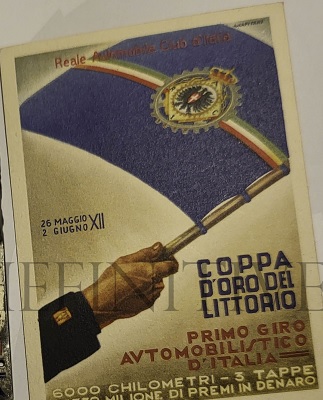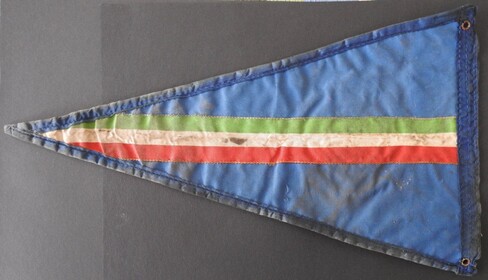
.jpg) images located by Esteban Rivera,
5 September 2025
images located by Esteban Rivera,
5 September 2025
Last modified: 2025-10-11 by rob raeside
Keywords: automobile club d'italia |
Links: FOTW homepage |
search |
disclaimer and copyright |
write us |
mirrors

.jpg) images located by Esteban Rivera,
5 September 2025
images located by Esteban Rivera,
5 September 2025
See also:
The "Automobile Club d'Italia, ACI" (Automobile Club of Italy) is an Italian
not-for-profit statutory corporation. As mentioned by Martin, it traces its
origins to the establishment of the "Automobile Club di Torino", which in 1904
adopted the denomination "Unione Automobilistica Italiana" (Italian Automobile
Union) with the aim of promoting the development of motoring in Italy, bringing
motorists together and organising sporting events. Also as mentioned before, it
grew into a national association of private origin on January 23, 1905 when it
joined together with other local automotive clubs, namely the "Automobile Club
di Firenze" (Automobile Club of Florence), "Automobile Club di Milano"
(Automobile Club of Milan) and "Automobile Club di Genova" (Automobile Club of
Genoa). It was recognized as a legal entity via "RD (Regio decreto) del
14/11/1926, n. 2481" (RD (Royal decree) n. 2481 of March 15, 1927) (https://www.normattiva.it/uri-res/N2Ls?urn:nir:stato:regio.decreto:1926-11-14;2481)
dependent on the "Presidenza del Consiglio dei Ministri - Commissariato per il
turismo" (Presidency of the Council of Ministers - Tourism Commissariat) and
designated a non-profit organization by "RDL (Regio decreto-legge) del
15/03/1927 n. 436" (RDL (Royal Decree-Law) n. 436 of March 15, 1927) (https://def.finanze.it/DocTribFrontend/decodeurn?urn=urn:doctrib::RDL:1927-03-15;436)
with the task of promoting and regulating the car sector and to represent car
owners' interests in the country. It was then designated a public organization
by "L (Legge) 20/03/1975, n. 70" (English: L (Legge) n. 70 of March 20, 1975) (https://www.normattiva.it/uri-res/N2Ls?urn:nir:stato:legge:1975-03-20;70).
Later on, with the new Statutes being approved via "D.P.R. (Decreto del
Presidente della Repubblica) del 08/09/1951, n.881" (Decree of the President of
the Republic n.882 of September 8, 1951) (https://www.gazzettaufficiale.it/eli/id/1950/11/16/050U0881/sg)
it was transformed into a "Federazione di Automobile Club" (Federation of
Automobile Club), with Provincial membership, yet autonomous legal status. It
currently has "98 Automobile Club provinciali" (98 Provincial Automobile Clubs)
affiliated.
An example of one of these Provincial Automobile Clubs is the
Automobile Club di Salerno (official website:
https://salerno.aci.it), whose images are
found below.
Its headquarters are located in Roma.
Sources:
https://aci.gov.it/laci/storia
https://aci.gov.it/attivita-e-progetti/il-club
https://www.museodelmarchioitaliano.it/en/aci-2
https://acipocket.it/2020/03/28/dal-1905-ad-oggi-storia-dellautomobile-club-ditalia
https://it.wikipedia.org/wiki/Automobile_Club_d%27Italia
In 2010 the Italian
design agency Inarea is tasked with the
design of the new logo, which "brings together in the same composition the three
strong elements of its iconographic tradition: the historical logotype of 1975 (https://www.museodelmarchioitaliano.it/wp-content/uploads/2022/09/marchio-aci-09.jpg) (although other sources mention 1977:
https://aci.gov.it//app/uploads/2024/05/21-9_1320x566_1977.jpg?ver=1718359647)
together with the cogwheel and the rhombus. In particular, the logotype breaks
the symmetry of the implant because it is connected to the toothed wheel through
a slight curvature of the letter 'I' ".
Source:
https://www.museodelmarchioitaliano.it/en/aci-2/
Esteban Rivera,
5 September 2025

.gif) images located by Esteban Rivera,
5 September 2025
images located by Esteban Rivera,
5 September 2025
Sources: https://catalogo.cultura.gov.it, https://aci.gov.it/
Picture caption reads: "Coppa d'oro del littorio. mano virile in camicia nera
sventola una bandiera blu con fascia tricolore e stemma del Reale Automobile
Club d'Italia al centro" (Golden Cup of the Littorio. A man's hand in a black
shirt waves a blue flag with a tricolor band and the emblem of the Royal
Automobile Club of Italy in the center). This advertisement poster features a
flag for the "Golden Cup" a non-championship competition that wanted to be
linked to the more traditional "Giro d'Italia automobilistico". Notice the
reference of the "camicia nera" (plural "camicienere") in reference to the "National
Fascist Party, Italy", at the time, the country's ruling party, in an event
held between May 26 and June 2, 1934 (source:
https://thefinitive.com/prodotto/raci-coppa-doro-del-littorio-badge-smaltato)
when they were in power.
Esteban Rivera,
5 September 2025

 reverse and obverse; images by Martin Karner, 12 July 2025
reverse and obverse; images by Martin Karner, 12 July 2025
Pennant of Reale Automobile Club d'Italia (RACI), 34x19 cm, between 1927 and
1946.
The club originated as the "Automobile Club of Turin" founded in Turin
on 6 December 1898. It first became a national association in 1905, named
Automobile Club d'Italia, when it joined together with other local automotive
clubs. In 1927 the corporate body was formed by royal decree, with the task of
promoting and regulating the car sector and to represent car owners' interests
in the country.
The corporation was called the Reale Automobile Club d'Italia
(RACI, "Royal Automobile Club of Italy") from then until 1946, when the monarchy
was abolished, and it dropped the royal appellation. Since then, the original
name Automobile Club d'Italia has been used again.
Info:
https://it.wikipedia.org/wiki/Automobile_Club_d%27Italia
Website:
https://www.aci.it/
Images source:
https://www.ricardo.ch/de/a/antiker-wimpel-automobilclub-italien-50er-jahre-vintage-1287424388/
Martin Karner, 12 July 2025
The 1927-1933 (other sources mention 1934) pennant is featured above. It displays the
1927-1933 logo, which is in the shape of a rhombus, depicted a golden eagle with
the Savoy cross, all inscribed in a toothed wheel over a blue pennant together
with the "tricolore", with new acronym RACI and the royal crown appear in the
logo.
Source: https://www.museodelmarchioitaliano.it/en/aci-2/
There
also seems to be a 1927-1933 flag which follows the same design pattern as the
pennant, only having a horizontal background instead.
Esteban Rivera, 5 September 2025